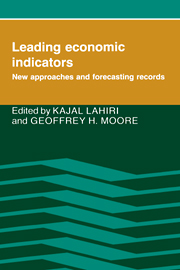Book contents
- Frontmatter
- Contents
- Preface
- List of contributors
- 1 Introduction
- PART I NEW CONCEPTS AND METHODS
- PART II FORECASTING RECORDS AND METHODS OF EVALUATION
- 9 Forecasting cyclical turning points: The record in the past three recessions
- 10 Turning point predictions, errors, and forecasting procedures
- 11 Forecasting peaks and troughs in the business cycle: On the choice and use of appropriate leading indicator series
- 12 Using a consensus of leading economic indicators to find the right ball park for real GNP forecasts
- 13 Some Australian experience with leading economic indicators
- 14 Turning point prediction with the composite leading index: An ex ante analysis
- 15 Forecasting recessions under the Gramm-Rudman-Hollings law
- 16 Leading indicators of inflation
- PART III NEW ECONOMIC INDICATORS
- Index
15 - Forecasting recessions under the Gramm-Rudman-Hollings law
Published online by Cambridge University Press: 05 June 2012
- Frontmatter
- Contents
- Preface
- List of contributors
- 1 Introduction
- PART I NEW CONCEPTS AND METHODS
- PART II FORECASTING RECORDS AND METHODS OF EVALUATION
- 9 Forecasting cyclical turning points: The record in the past three recessions
- 10 Turning point predictions, errors, and forecasting procedures
- 11 Forecasting peaks and troughs in the business cycle: On the choice and use of appropriate leading indicator series
- 12 Using a consensus of leading economic indicators to find the right ball park for real GNP forecasts
- 13 Some Australian experience with leading economic indicators
- 14 Turning point prediction with the composite leading index: An ex ante analysis
- 15 Forecasting recessions under the Gramm-Rudman-Hollings law
- 16 Leading indicators of inflation
- PART III NEW ECONOMIC INDICATORS
- Index
Summary
The Gramm-Rudman-Hollings (GRH) law passed by the Congress in December 1985 establishes a process whereby the Federal budget deficits are to be gradually phased out by the fiscal year (FY) 1991. A series of targeted ceilings on the unified budget deficit is instituted, beginning with $172 billion for FY 1986 and $144 billion for FY 1987 and proceeding by decrements of $36 billion per year to zero in FY 1991. The planned reductions are to be achieved by spending and tax measures agreed upon by the legislative and executive branches of the U.S. government. However, if an agreement is not reached, the target for any FY is to be achieved through an automatic across-the-board spending cut in all eligible defense and nondefense categories. Early in 1986 a lower court ruled that the sequestering provision of GRH is unconstitutional; this ruling was confirmed by the Supreme Court on July 7, 1986. This does not pertain to the issues discussed in this paper.
Section 254 of the GRH law provides for “Special Procedures in the Event of a Recession.” It states that the Congressional Budget Office (CBO) Director shall notify the Congress at any time (a) if the CBO or the Office of Management and Budget (OMB) “as determined that real economic growth is projected or estimated to be less than zero with respect to each of any two consecutive quarters” within a period of six successive quarters starting with the one preceding such notification, or (b) “if the Department of Commerce preliminary report of actual real economic growth (or any subsequent revision thereof) indicates that the rate of real economic growth for each of the most recent reported quarter and the immediately preceding quarter is less than one percent.”
- Type
- Chapter
- Information
- Leading Economic IndicatorsNew Approaches and Forecasting Records, pp. 257 - 274Publisher: Cambridge University PressPrint publication year: 1991
- 2
- Cited by



